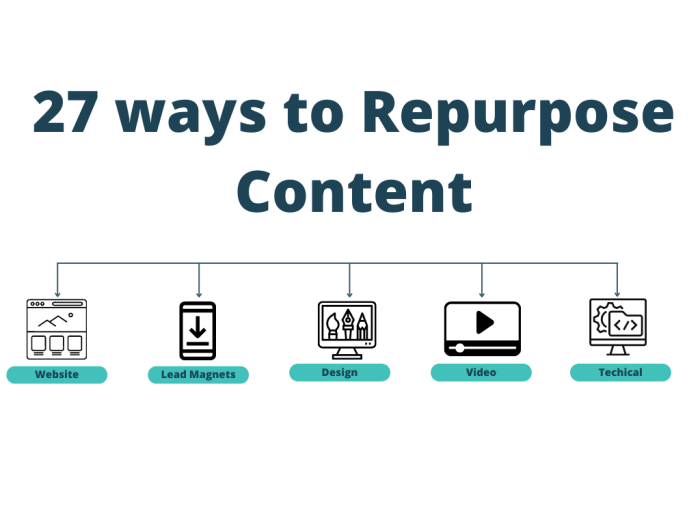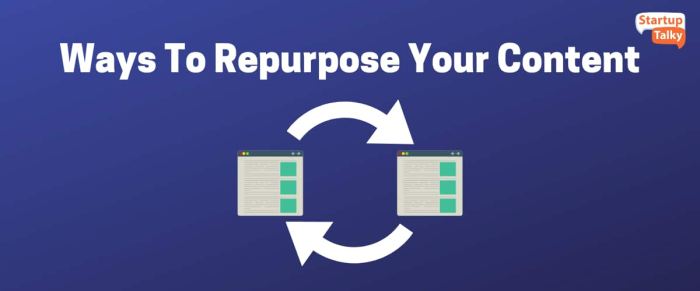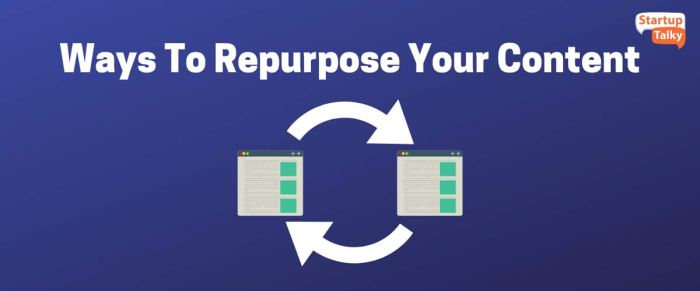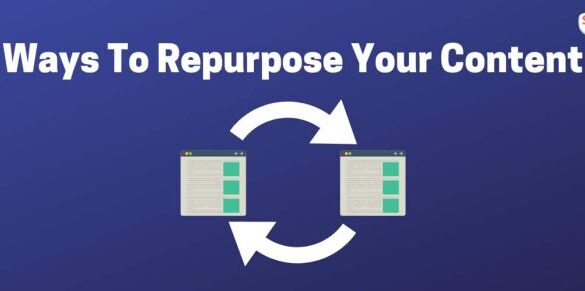How to repurpose your content the right way is crucial for maximizing your reach and engagement. Instead of creating new content from scratch, you can transform existing blog posts, videos, infographics, and social media posts into various formats. This approach saves valuable time and resources while boosting your online presence. This guide breaks down the process, from understanding repurposing to optimizing your content for different platforms and measuring success.
This detailed guide will show you how to identify repurposing opportunities, select the right strategy, and master various content formats. We’ll cover everything from transforming a blog post into a social media series to optimizing repurposed content for different platforms and measuring its impact. Get ready to unlock the potential of your existing content and amplify your message!
Understanding Content Repurposing
Content repurposing is essentially taking existing content and transforming it into a new format to reach a wider audience and maximize its impact. Instead of creating entirely fresh material, this strategy leverages existing assets, saving time and resources while boosting overall content strategy effectiveness. It’s a smart way to get more mileage out of your efforts and keep your audience engaged with consistent, valuable information.This approach allows you to reach a broader spectrum of potential readers and viewers, ensuring your message resonates with diverse audiences.
It’s a cost-effective method for expanding your content’s visibility and driving higher engagement rates.
Defining Content Repurposing
Content repurposing is the process of transforming existing content into new formats to reach different audiences or channels. This involves taking, for example, a blog post and turning it into a social media post, a video, or an infographic. The core benefit is maximizing the value of your existing content by expanding its reach and impact.
Content Formats for Repurposing
Repurposing allows you to adapt your content to various formats, catering to diverse audience preferences. Examples of content formats suitable for repurposing include:
- Blog posts: Can be transformed into social media posts, email newsletters, or short videos.
- Videos: Can be broken down into shorter clips, transcribed into blog posts, or used as inspiration for social media graphics.
- Infographics: Can be adapted into presentations, blog posts, or social media posts.
- Social media posts: Can be compiled into blog posts, infographics, or even longer-form articles.
Reasons for Content Repurposing
Repurposing content is vital for achieving maximum reach and engagement across various platforms. Here’s why:
- Increased Visibility: By distributing your content across different platforms, you expose it to a wider audience, potentially reaching new readers and viewers who might not have discovered it otherwise.
- Enhanced Engagement: Different formats cater to various preferences. Repurposing allows you to engage different segments of your audience with formats they prefer, leading to greater interaction and participation.
- Cost-Effectiveness: Repurposing existing content is significantly cheaper than creating entirely new content from scratch. This saves time and resources, allowing you to invest in other areas of your strategy.
Time and Resource Savings
Repurposing content significantly reduces the time and resources needed compared to creating original content. It’s an effective way to maximize your existing efforts, avoiding the need to start from scratch for each new platform or format.
Repurposing saves valuable time and resources by leveraging existing content, optimizing for different platforms and maximizing return on investment.
Identifying Repurposable Content
Identifying existing content ripe for repurposing requires a strategic approach. Analyze your existing content library, noting which pieces have performed well in the past. Consider topics that are still relevant and have a strong potential for attracting a wider audience.
- Analyze Content Performance: Look for pieces that have received high engagement, such as blog posts with many comments, popular videos, or frequently shared social media posts.
- Assess Content Relevance: Determine if the content remains relevant to your current audience. If a topic is trending or if there’s a need for updated information, repurposing it can be very beneficial.
- Review Content Formats: Identify existing content that could be adapted to different formats. For example, a blog post could be repurposed into a short video or an infographic.
Identifying Repurposing Opportunities
Repurposing content is a powerful strategy to maximize the value of your existing assets. It’s not just about recycling; it’s about strategically transforming your content into different formats to reach a wider audience and generate new leads. This process requires careful analysis and a keen understanding of your audience’s preferences.Effective repurposing hinges on identifying the optimal ways to transform your content.
This involves recognizing opportunities within your existing content library and understanding how to adapt it to different channels and formats. This crucial step often leads to increased visibility, improved engagement, and ultimately, a greater return on investment for your content marketing efforts.
Analyzing Different Types of Content for Repurposing, How to repurpose your content the right way
Different content formats offer varying opportunities for repurposing. Blog posts, for example, can be transformed into infographics, social media updates, or even short videos. Similarly, webinars or podcasts can be broken down into individual blog posts, short-form videos, or downloadable guides. Understanding the intrinsic value of each format allows you to select the best repurposing strategy.
Assessing Performance of Existing Content
Analyzing the performance of existing content is paramount. Tools like Google Analytics can provide valuable insights into which content pieces resonate most with your audience. Tracking metrics like engagement (time spent on page, click-through rates), reach (social shares, website traffic), and conversions (leads generated, sales made) helps you pinpoint the most effective content for repurposing.
Determining the Best Format for Repurposing
Selecting the optimal format for repurposing depends on the specific content piece and target audience. A detailed analysis of your audience’s preferred consumption methods is key. For example, if your audience is visually inclined, infographics or short videos might be more effective than long-form blog posts. A technical whitepaper, on the other hand, might be more effectively repurposed as a series of short, engaging videos.
Repurposing content effectively is key to maximizing your reach and engagement. Instead of creating fresh content all the time, think about how to transform existing pieces into different formats. This could be turning a blog post into a video or an infographic, or maybe even a series of tweets. To truly understand the potential of content repurposing, you need to consider whether content marketing is a viable lead generation tactic; after all, effective repurposing relies on the original content’s ability to attract leads in the first place.
Is content marketing a viable lead generation tactic ? Ultimately, the right repurposing strategy leverages existing assets to attract more customers and build a stronger online presence.
Evaluating Audience Engagement with Various Formats
Assessing audience engagement with different formats is crucial for successful repurposing. A/B testing is a powerful technique for evaluating different formats and versions of the same content. By presenting alternative formats to segments of your audience and monitoring their responses, you can determine which resonates best and make data-driven decisions about future repurposing efforts. Qualitative feedback, such as surveys or social media polls, can further refine your understanding of audience preferences.
Forecasting Potential Reach and Impact of Repurposed Content
Predicting the reach and impact of repurposed content involves considering factors such as target audience size, existing content popularity, and the chosen repurposing format. For example, a popular blog post with a large social media following could potentially reach a significantly larger audience when repurposed into a short video series. Historical data on similar repurposing efforts within your industry can provide valuable insights into potential outcomes and expected impact.
Repurposing content effectively is key to maximizing its reach. Think about transforming a blog post into a series of tweets, or turning a video into an infographic. Understanding how to handle 301 redirect chains intro 301 redirect chains intro is crucial for this process. Proper redirects ensure a smooth transition for your audience, preventing broken links and lost traffic, which ultimately enhances your content’s lifespan and impact.
In essence, anticipating the potential impact helps in resource allocation and strategy optimization.
Choosing the Right Repurposing Strategy
Repurposing content is a powerful way to maximize the value of your existing work. However, simply taking an existing piece and slapping a new headline on it rarely yields optimal results. A well-considered repurposing strategy is crucial for reaching a wider audience and achieving your content marketing goals. This involves carefully evaluating your content, understanding your target audience, and selecting the most effective format for each platform.Effective repurposing goes beyond simply changing the format.
It’s about understanding how different formats resonate with different audiences and adapting your message accordingly. A blog post might be perfectly suited for a short-form video on YouTube, but a lengthy whitepaper could benefit from a series of tweets and LinkedIn posts. The key is to leverage the strengths of each format to maximize reach and impact.
Selecting Repurposing Strategies Based on Content Type
Different content types lend themselves to different repurposing strategies. A long-form blog post, for example, can be broken down into multiple shorter articles, snippets for social media, or even a podcast episode. An infographic can be transformed into a presentation, a social media campaign, or a series of blog posts explaining the data visually presented. Recognizing the inherent strengths of each format allows for a more effective repurposing strategy.
Determining Optimal Content Format
Developing a process for determining the optimal format is crucial for success. First, analyze the existing content for its core message, key takeaways, and target audience. Next, identify the platforms and channels where your target audience spends their time. Consider the format’s suitability for each platform. A concise, impactful headline is as important for a short-form video as it is for a blog post.
| Content Type | Optimal Repurposing Format | Example |
|---|---|---|
| Blog Post (Long-Form) | Short-form articles, social media snippets, podcast episode, infographic | A 1500-word blog post on best practices can be transformed into a 5-part series of tweets, a 10-minute podcast episode, and short blog articles focusing on specific techniques. |
| Infographic | Presentation, social media campaign, blog post series, short videos | An infographic visualizing data on customer acquisition costs can be used in a company presentation, a social media campaign highlighting the data, or a blog series explaining each part of the infographic in detail. |
| White Paper | LinkedIn posts, tweets, summary articles, webinar | A detailed white paper on digital marketing trends can be broken down into shorter LinkedIn posts discussing individual trends, summarized in articles, or used as the basis for a webinar. |
Comparing and Contrasting Repurposing Techniques
Various techniques exist for repurposing content. These include condensing long-form content into shorter formats, extracting key takeaways into social media posts, or transforming text into visual formats like infographics or videos. The choice of technique depends on the content’s original format, the target platform, and the desired outcome.
- Condensing: Reducing the length of a piece of content to make it more accessible for different platforms. This is often suitable for long-form content, such as blog posts or white papers.
- Extracting Key Takeaways: Highlighting the most important points from a piece of content and presenting them in a concise format, often using bullet points or numbered lists.
- Visual Transformation: Converting text-based content into visual formats, such as infographics or videos, to make it more engaging and accessible to a wider audience. This is particularly effective when the original content contains data or complex information.
Tailoring Repurposed Content
Successfully repurposed content must be tailored to each platform and audience. A blog post about best practices, for example, might be repurposed into a series of short, engaging tweets targeting a specific audience interested in digital marketing strategies.
Measuring Repurposing Effectiveness
Tracking the performance of different repurposing strategies is vital. Utilize analytics to monitor engagement metrics like clicks, shares, comments, and conversions. A clear framework for tracking these metrics will provide insights into which strategies are most effective.
Repurposing Content Formats

Content repurposing isn’t just about saving time; it’s about maximizing the value of your existing assets. By strategically transforming content from one format to another, you can reach wider audiences and boost engagement across various platforms. This approach is crucial for maintaining a consistent brand voice and message, while also ensuring your content is accessible to diverse audiences and various consumption preferences.Different formats allow for different types of engagement.
Repurposing lets you leverage the strengths of each format to amplify your message and reach a broader audience. This flexibility is vital for content marketers who want to make the most of their efforts.
Transforming a Blog Post into a Social Media Series
A blog post can be easily segmented into a compelling social media series. This strategy effectively extends the lifespan of your content, maximizing engagement and driving traffic back to your website. Each post in the series can focus on a specific section or key takeaway from the original blog.
- Identify key takeaways: Carefully review your blog post to pinpoint the most important points, concepts, or actionable insights. Choose the aspects most likely to resonate with your target audience on social media.
- Create concise social media posts: Each post should be a standalone piece of content, ideally with an eye-catching image or video. Use strong calls-to-action (CTAs) to encourage interaction and direct readers to the original blog post.
- Establish a posting schedule: A consistent posting schedule will keep your audience engaged and anticipating the next post in the series. Consider factors like your audience’s preferred posting times and platform algorithms.
- Use relevant hashtags: Utilize relevant hashtags to increase discoverability. Ensure your hashtags align with your target audience’s interests and help categorize your content.
Converting a Video into an Infographic
Videos, rich with visual and audio information, can be condensed and presented in a more digestible format through infographics. This transformation allows for a quick and effective way to communicate key takeaways and data visually.
Repurposing content effectively is key to maximizing its impact. Think about how you can transform a blog post into a series of tweets, or a webinar into a downloadable infographic. Understanding the user engagement features framework is crucial here; you can tailor your repurposed content to resonate with your target audience by understanding what motivates them to engage with your brand, like interactive polls or personalized recommendations within the user engagement features framework.
This approach will lead to a more engaging experience for your audience, ultimately driving better results from your content.
- Identify key takeaways: Carefully review the video to determine the most important information, statistics, or data points. Focus on the core messages that need to be communicated visually.
- Select the most impactful visuals: Choose visuals from the video that effectively illustrate the data points and support the key takeaways. Think about the best visual representations for different types of data (bar charts, pie charts, etc.).
- Organize data into a logical flow: Structure the infographic with clear headings, subheadings, and visual cues to guide the viewer through the information.
- Use concise and impactful text: Keep the text on the infographic brief and to the point. Prioritize visual communication over lengthy descriptions.
Turning an Infographic into Social Media Posts
Infographics are highly visual and shareable, making them excellent candidates for social media promotion. This strategy can significantly extend the reach and lifespan of your valuable infographic.
- Break down the infographic into smaller chunks: Divide the infographic’s information into smaller, more manageable pieces. Each social media post should focus on a specific section or key takeaway from the infographic.
- Create compelling visuals: Use captivating visuals, relevant images, or screenshots from the infographic for each post. Ensure the visuals clearly communicate the message and attract attention.
- Craft engaging captions: Write concise and engaging captions that highlight the key points of each post and encourage interaction. Use questions, calls to action, and relevant hashtags.
- Promote cross-promotion: Link each social media post back to the original infographic or blog post for further information and engagement.
Repurposing a Podcast into Blog Posts and Articles
Podcasts provide valuable insights and information, which can be easily repurposed into blog posts and articles. This repurposing can expand your reach beyond the audio platform and cater to a broader audience.
- Identify key themes and topics: Carefully listen to your podcast episodes to pinpoint recurring themes, key arguments, or actionable advice. These topics will form the basis for your blog posts.
- Create a script for each post: Translate the key insights and information from each podcast episode into a well-structured blog post. Ensure the blog post remains consistent with your brand voice and style.
- Add visual elements: Enhance the blog post with relevant images, videos, or transcripts from the podcast to improve readability and engagement.
- Optimize for search engines: Use relevant s and meta descriptions to increase the visibility of your blog posts in search engine results.
Structuring Repurposed Content
Repurposing content isn’t just about changing the format; it’s about strategically adapting the message to resonate with different audiences and platforms. Effective repurposing requires a structured approach that considers the unique characteristics of each platform and the specific needs of your target audience. This involves more than just a simple rewrite; it’s about thoughtfully crafting content that maintains its core message while engaging the reader in a way that’s tailored to the chosen platform.Successful repurposing hinges on understanding how to maintain the essence of your original content while presenting it in a fresh and engaging way for a new audience.
This involves careful planning, thoughtful adaptation, and a clear understanding of each platform’s strengths and limitations.
Design Templates for Repurposing Content Across Different Platforms
Different platforms demand different approaches. A template for repurposing content should consider the platform’s visual style, typical post length, and audience engagement patterns. For example, a long-form blog post might be broken down into shorter, more digestible social media updates, or a presentation might be converted into a series of informative infographics.
Examples of HTML Table Structures for Organizing Repurposed Content (4 Responsive Columns)
Tables can be powerful tools for organizing data and information in repurposed content. They’re particularly effective for presenting lists of key takeaways, comparative analyses, or summaries of complex topics. A responsive table design ensures that the table adapts to different screen sizes, guaranteeing a positive user experience.
| Original Content Topic | Social Media Platform | Repurposed Content Format | Key Takeaway |
|---|---|---|---|
| Strategies for Beginners | Short, informative tweets | Prioritize research. | |
| Top 5 Productivity Tips | Infographic | Time management is key. | |
| Marketing Trends 2024 | Blog post excerpt | AI-powered marketing is on the rise. |
Adapting Content for Various Social Media Platforms
Each social media platform has a unique character. Twitter, for instance, favors brevity and quick consumption. Conversely, LinkedIn prioritizes professional content and detailed explanations. Therefore, repurposing content for these platforms requires adaptation. Consider the platform’s typical post length, image/video preferences, and typical engagement style.
- Twitter: Break down key points from a blog post into concise tweets. Use relevant hashtags and engaging visuals to capture attention.
- LinkedIn: Repurpose articles into concise, professional posts. Highlight key takeaways and add links to your original content.
- Instagram: Create visually engaging infographics or short videos. Focus on high-quality images and concise captions.
Structuring Content Using HTML Blockquotes to Highlight Key Points
Blockquotes can effectively emphasize important sections or quotes from the original content. This method improves readability and allows you to highlight key takeaways for a new audience.
“Content repurposing is about strategically adapting your message for different platforms and audiences.”
Elaboration on the Use of Visuals in Repurposed Content (Image Descriptions)
Visuals play a crucial role in attracting attention and conveying information more effectively. High-quality images and videos are particularly important for social media platforms. The images should not only be aesthetically pleasing but also directly relate to the repurposed content.A well-designed infographic summarizing key data points from a longer article, for instance, can effectively communicate complex information to a broader audience.
Visuals should always be accompanied by clear, concise descriptions that accurately reflect the image’s content and its relation to the repurposed material.
Optimizing Repurposed Content for Different Platforms

Repurposing content is a powerful strategy for maximizing your reach and impact. However, simply taking existing content and slapping it onto a different platform rarely yields optimal results. To truly leverage repurposing, you need to understand the nuances of each platform and tailor your content accordingly. This involves more than just changing the headline; it requires a thoughtful approach to language, tone, visuals, and overall presentation.Effective repurposing involves understanding the specific audience and expectations of each platform.
A humorous tweet might not resonate on a LinkedIn post, and a lengthy blog post might be better served as a series of Instagram carousels. This chapter will delve into how to optimize your repurposed content for maximum impact on various platforms.
Tailoring Language and Tone
Different social media platforms have distinct cultural norms and expectations regarding language and tone. Understanding these nuances is crucial for effective communication. A formal, academic tone might be appropriate for LinkedIn, but would likely fall flat on platforms like TikTok or Instagram. Conversely, a casual, playful tone might work well on platforms like Twitter or Instagram but would be inappropriate for professional networking sites.
Adjusting Visuals and Design
Visuals are paramount on most social media platforms. The design elements, such as image size, color palettes, and use of graphics, should be adapted to each platform’s specifications. For example, a high-resolution image suitable for a blog post might need to be resized and compressed for Instagram. Consider using platform-specific design templates and tools to ensure your visuals fit the platform’s aesthetic.
Additionally, consider the platform’s recommended aspect ratios for images and videos.
Optimizing for Mobile Devices
Mobile devices are the primary access point for most social media users. Therefore, your repurposed content must be optimized for mobile viewing. This means ensuring readability, using responsive design, and considering the limitations of mobile screens. Images should load quickly, text should be easily readable, and calls to action should be clear and prominent.
Platform-Specific Best Practices
| Platform | Best Practices |
|---|---|
| Short, punchy messages; use relevant hashtags; engage with the community; focus on timely trends. | |
| Longer-form posts; incorporate visually appealing images and videos; encourage interaction; use targeted advertising. | |
| Visually driven content; use high-quality images and videos; leverage Instagram Stories and Reels; use relevant hashtags and location tags. | |
| Professional tone; share insightful articles and industry news; network with peers; use relevant s. | |
| TikTok | Short-form videos; use trending audio and effects; focus on creativity and humor; engage with the community. |
Optimization Checklist for Each Platform
- Twitter: Craft concise tweets with compelling visuals, relevant hashtags, and timely commentary. Include a clear call to action.
- Facebook: Share engaging posts with high-quality images or videos. Ask questions to encourage interaction. Use Facebook groups for targeted content and engagement.
- Instagram: Create visually appealing posts with high-quality images and videos. Utilize Instagram Stories for behind-the-scenes content or quick updates. Use relevant hashtags and location tags.
- LinkedIn: Share insightful articles, industry news, and personal updates in a professional tone. Network with industry professionals and participate in relevant discussions. Focus on adding value and establishing yourself as a thought leader.
- TikTok: Create short-form videos that are engaging and creative. Use trending audio and effects. Focus on humor and creativity to grab attention.
Measuring the Success of Repurposing Efforts: How To Repurpose Your Content The Right Way
Repurposing content is a powerful strategy for maximizing the reach and impact of your initial efforts. However, simply repackaging content isn’t enough. To truly understand the effectiveness of your repurposing, you need a robust system for measuring its success. This involves tracking key metrics and analyzing the performance of different repurposing strategies.Successfully repurposed content generates a return on investment by extending the life of your original content and driving new engagement.
Understanding how your repurposed content performs across different platforms allows you to refine your strategy and achieve better results.
Key Metrics for Evaluating Success
A crucial aspect of measuring repurposing success is identifying the right metrics. These metrics should align with your overall content marketing goals. Common metrics include website traffic, social media engagement, lead generation, and conversions. Tracking these metrics allows you to assess the impact of your repurposing efforts and adjust your strategy as needed.
Tracking Engagement and Reach
Monitoring engagement and reach for repurposed content is vital. Tools like Google Analytics, social media analytics platforms, and email marketing platforms provide detailed data on how your audience interacts with your content. This data includes metrics like click-through rates, time spent on page, shares, comments, and likes.
Analyzing Repurposed Content Performance
Regularly analyzing the performance of repurposed content is critical for refining your strategy. A structured approach to analysis allows you to identify patterns and trends in your data. The table below illustrates a sample format for analyzing the performance of repurposed content:
| Repurposed Content | Platform | Original Content | Date of Repurposing | Engagement Metrics (e.g., views, shares, comments) | Reach Metrics (e.g., impressions, followers gained) | Conversion Rate (if applicable) | Analysis & Next Steps |
|---|---|---|---|---|---|---|---|
| Blog post summary on LinkedIn | Blog post “Content Repurposing Strategies” | 2024-03-15 | 150 views, 10 shares, 5 comments | 300 impressions, 2 new followers | 2% | Continue using this strategy for other blog posts. | |
| Instagram Reel of blog tips | Blog post “Content Repurposing Strategies” | 2024-03-18 | 500 views, 20 saves, 5 comments | 1000 impressions, 1 new follower | 0.5% | Experiment with different video editing styles and captions. |
Importance of A/B Testing
A/B testing is crucial for optimizing repurposed content. By comparing different versions of the same repurposed content, you can identify which elements resonate most with your audience. This could include variations in headlines, images, calls to action, or even the platform used. For example, testing different headlines for a repurposed blog post on LinkedIn can significantly impact engagement.
Examples of Measuring Repurposing Effectiveness
A successful repurposing strategy should yield demonstrable results. For instance, if a blog post on content marketing is repurposed into a series of tweets, a significant increase in website traffic and social media engagement could indicate a successful strategy. Similarly, repurposing a webinar into a series of email newsletters can generate new leads and build a strong email list.
Measuring the increase in email sign-ups, compared to the original webinar attendance, provides concrete data for evaluating repurposing success.
Closure
In conclusion, repurposing your content is a powerful strategy for expanding your reach and engagement without starting from scratch. By understanding the various content formats, choosing the right strategy, and optimizing your repurposed content for different platforms, you can effectively leverage your existing materials to maximize your impact. Remember to measure the success of your efforts to refine your strategies and continually improve your content repurposing approach.
This guide provides a comprehensive framework for a successful content repurposing strategy, setting you up for success.









